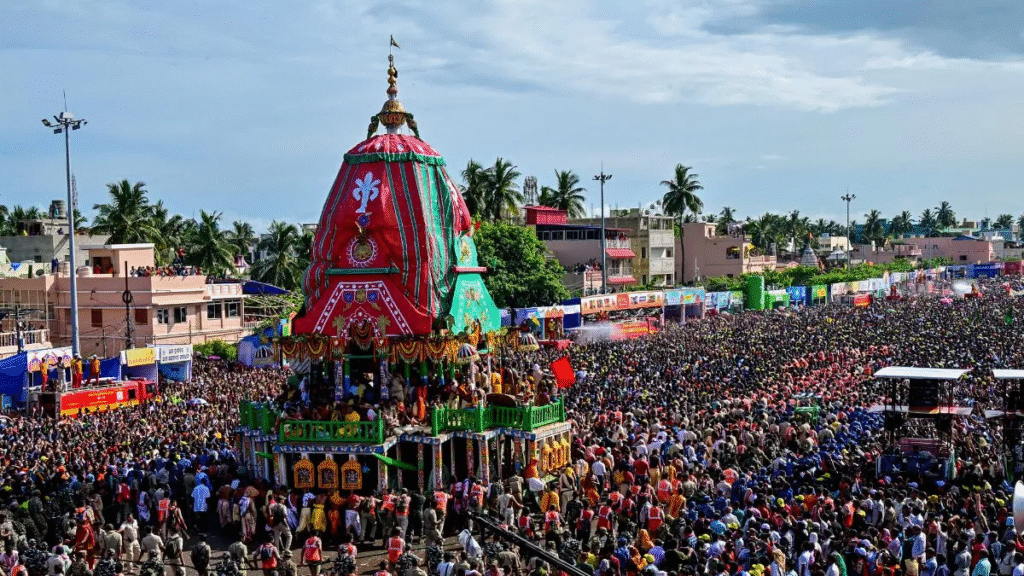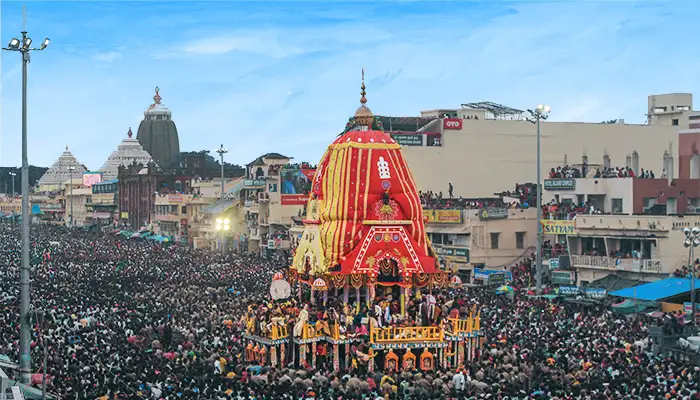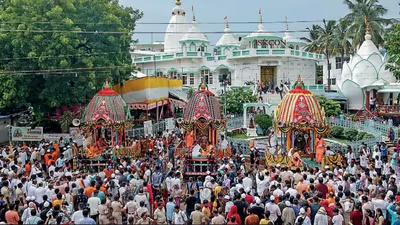Rath Yatra 2025 begins today, June 27, in Puri as millions gather for Lord Jagannath’s chariot procession. Discover full schedule, route, rituals, and key dates for this 9-day divine celebration
On June 27, 2025, the holy town of Puri in Odisha transforms into a spiritual epicenter as it hosts one of the largest and most revered Hindu festivals — Rath Yatra or the Chariot Festival of Lord Jagannath, along with his siblings Lord Balabhadra and Goddess Subhadra. Drawing over a million pilgrims annually, this 9-day festival is a vibrant celebration of devotion, unity, tradition, and divine spectacle.

This year, Rath Yatra holds added excitement as the ritual calendar aligns with an auspicious constellation, and preparations have been on for months to ensure the divine procession unfolds smoothly and safely.
| Date | Event |
|---|---|
| June 27, 2025 | Rath Yatra (Main procession begins) |
| July 5, 2025 | Bahuda Yatra (Return journey) |
| July 6, 2025 | Suna Besha (Golden attire ceremony) |
| July 7, 2025 | Niladri Bije (Re-entry into the temple) |
Total Duration: 11 days (including pre-rituals and return events)
Main Procession Day: June 27, 2025 (Dwitiya Tithi)
The divine trio embark on a journey from their main abode – Shri Jagannath Temple – to their aunt’s place – Gundicha Temple, situated about 3 kilometers away. Here’s how the route unfolds:

- Start Point: Shri Jagannath Temple, Bada Danda (Grand Road), Puri
- Chariots’ Order:
- Balabhadra leads the procession (Chariot: Taladhwaja)
- Subhadra follows next (Chariot: Darpadalana)
- Jagannath comes last (Chariot: Nandighosa)
- End Point: Gundicha Temple, where the deities stay for 7 days
Each deity has a uniquely crafted chariot, meticulously built each year from scratch by traditional artisans using Neem wood (Daru).
| Deity | Chariot Name | Height | Wheels | Color |
|---|---|---|---|---|
| Lord Jagannath | Nandighosa | 45 feet | 16 | Red & Yellow |
| Lord Balabhadra | Taladhwaja | 44 feet | 14 | Red & Green |
| Goddess Subhadra | Darpadalana | 43 feet | 12 | Red & Black |
Each chariot is decorated with silken canopies, floral garlands, and symbolic motifs, and pulled using long coir ropes by lakhs of devotees – a sight symbolic of the people’s devotion drawing the Lord closer to their hearts.
Pahandi Bije (June 27 Morning): The deities are brought out in a majestic procession from the sanctum sanctorum, one after another, amid chanting, music, and conch blowing.
Chhera Pahanra: The ceremonial sweeping of the chariots by the Gajapati King of Puri, symbolizing humility before the divine.
Rath Pulling (Afternoon to Evening): Begins post noon after rituals conclude. Devotees pull each chariot on Bada Danda toward Gundicha Temple.
Stay at Gundicha Temple (7 Days): The deities rest here before their return journey.
Bahuda Yatra (July 5): The return trip of the chariots to Jagannath Temple.
Suna Besha (July 6): Lord Jagannath, Balabhadra, and Subhadra are adorned in gold ornaments atop their chariots.
Niladri Bije (July 7): Re-entry of the deities into the sanctum of the temple, marking the conclusion of the Yatra.
The festival isn’t just a cultural extravaganza; it holds deep spiritual meaning:
- Symbol of Equality: Anyone — regardless of caste, creed, or status — can pull the chariot. It’s one of the few occasions when Lord Jagannath emerges from his temple to meet devotees.
- Metaphor for Life: The journey of the Lord from one temple to another represents the cycle of life, with periods of travel, rest, adornment, and return.
- The Pulling of the Chariot: Symbolizes the inner desire of the soul (devotees) to draw the divine into their lives and consciousness.
Given the massive scale of Rath Yatra, security remains paramount.
- 10,000+ security personnel including NDRF, ODRAF, RAF, and police deployed
- 100+ CCTV cameras with facial recognition on key roads
- Drone surveillance for live crowd and traffic monitoring
- Medical kiosks, mobile clinics, and temporary shelters across the route
- Mobile toilets and water stations for pilgrims
- Digital LED screens installed across Puri to broadcast rituals live
Odisha Government has also launched a dedicated Rath Yatra 2025 app and website for pilgrims to track live darshan, traffic updates, and chariot movement.
Rath Yatra is no longer a local event — it’s a global spiritual movement. Temples in the U.S., U.K., Australia, Singapore, Canada, and parts of Europe are hosting their own symbolic versions of the Yatra.

The ISKCON network also plays a pivotal role in expanding the reach of Rath Yatra to global audiences.
For those who can’t attend physically, major Indian news channels and religious platforms like DD National, Odisha TV, and YouTube Live Streams are providing uninterrupted coverage.
Puri sees a dramatic spike in tourism during Rath Yatra. Hotels, guesthouses, and dharamshalas are booked months in advance.
- Estimated 1.5 to 2 million pilgrims visit during the Yatra
- Local artisans, flower sellers, priests, and food vendors see massive uptick in business
- Traditional souvenirs such as Patta paintings, conch jewelry, Jagannath idols, and handwoven fabrics are in high demand
The origins of the Rath Yatra date back over a millennium, with scriptural mentions in the Skanda Purana, Brahma Purana, and Padma Purana. The custom of constructing new chariots every year and the role of the Gajapati King underscore its timeless traditions.
Read Also : Mumbai Weather Alert: Colaba Records 90mm Above Average Rainfall, City Braces for 4.87m High Tide















 Categories
Categories









